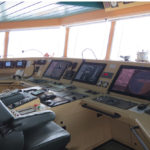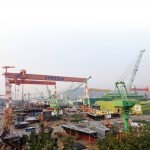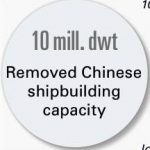Zeng Xiaolin looks at how Chinese, South Korean and Japanese shipbuilders are reacting to the downturn with structural changes and financial instruments for clients
The deterioration of the Baltic Dry Index to a historic low has combined with weak oil prices to create turmoil[ds_preview] in East Asia’s shipbuilding industries. Newbuilding orders have become hard to come by, while shipbuilders with existing orders for bulk carriers and drillships have found themselves facing cancellations or deferred deliveries.
China: overcapacity woes
Ren Yuanlin, executive chairman of Yangzijiang Shipbuilding, China’s biggest non-state-owned shipbuilder, told HANSA that the overcapacity in the shipbuilding industry remains unresolved. Ren said, »I think the consolidation in China’s shipbuilding industry will be modelled after that in South Korea and Japan, where the ten biggest shipbuilders have the biggest share of orders.« Yangzijiang itself was asked if it wanted to acquire struggling compatriot shipbuilder China Rongsheng Heavy Industries, but Ren said that any merger should be synergistic and not merely to expand his company’s capacity. »Rongsheng and Yangzijiang build similar vessels so I don’t see any synergies here,« said Ren.
China Association of the National Shipbuilding Industry’s figures showed that the output of Chinese yards stood at 41.8mill. dwt in 2015, just up 7.1% year-on-year, but the newly received orders were 47.9% lower than the previous year, at 31.26mill. dwt. The orderbook of Chinese yards also dropped, by 12.3% year-on-year to 123mill. dwt.
Surviving Chinese shipbuilders can, however, count on the country’s financial institutions for support. China Export & Credit Insurance Corporation (Sinosure), one of China’s export credit providers, has developed its ship finance insurance business from 2009 to 2014, with insured amounts exceeding 10mill. $ for more than 150 vessels. Sinosure facilitates bank loans to shipbuilders and ship owners, by insuring the loans against defaults. The organisation works with both Chinese and foreign banks.
Speaking at a recent shipping conference, Sinosure’s deputy general manager Chen Zhijun noted that shipbuilders face difficulties winning orders and securing finance, while the risk of contract cancellations remains high. Chen said, »The low down payments (20%) from the ship owners have exposed shipyards to relatively high risk. Insurance can cover such losses, if the ship owners cancel the shipbuilding contract, and can help the shipyards to be funded by financial institutions while the vessel is being built.«
sSouth Korea: hit by oil glut
South Korea’s three biggest shipbuilding companies– Hyundai Heavy Industries, Samsung Heavy Industries and Daewoo Shipbuilding & Marine Engineering – have paid a heavy price for focusing on drillships. While the trio’s research and development of drillships served them well when oil and gas prices were high, the situation has reversed. Customers who ordered drillships speculatively are now deferring the vessel deliveries or cancelling the contracts.
The scenario is the same for LNG carriers and floating LNG (FLNG) vessels, as oversupply in the former segment has caused ship owners to stop speculative orders. As for FLNG, the decline in gas prices has made oil majors rethink capital investment plans.
All three shipbuilders posted losses for 2015. HHI reported a 1.36 tr KRW (1.14 bn $) loss; SHI reported a 1.2 tr KRW (1 bn $) loss and DSME incurred a record 5.1 tr KRW (4.2 bn $) loss. Daewoo’s massive loss was widely expected after the shipbuilder admitted in July 2015 that it had concealed some 3 tr KRW in losses from drillship and offshore facility orders.
DSME’s two main creditors, Korea Development Bank and Export-Import Bank of Korea (KEXIM), offered a 4 tr KRW bailout plan, on condition the shipbuilder undertake massive restructuring, including selling non-core businesses. DSME CEO Jung Sung-leep said at a press briefing on 10 March that 12,000 jobs would be cut as the shipbuilder wants to reduce the payroll to 30,000 staff by 2019. But a DSME spokesman told HANSA that this would be achieved through natural attrition. The spokesman said, »The company will reduce workforce to 30,000 (including affiliates) by 2019 to improve its productivity. But this doesn’t necessarily mean that it will carry out a large scale restructuring and cut massive numbers of employees. It will be a natural reduction. The workforce would reduce gradually as subcontracted workers and temporary employees hired by affiliates stop working when their contracts expire.«
HHI chairman Choi Gil-seon said in his New Year’s address that more consolidation is needed to overcome a slowing world economy and a tough shipping market. Choi said, »We should cut costs by re-examining our labour costs, business structure and processes.« While HHI and SHI are restructuring through job and salary cuts, they and DSME are refocusing on commercial vessels, on the likelihood that there will be more orders for oil and product tankers. Tanker freight rates have been firming since the drop in oil prices catalysed imports of oil and petroleum products. SHI officials, however, told HANSA that the shipbuilder will not stop R&D in drillships and FLNG, as it takes a long-term view of the market. »Oil and gas prices are cyclical. Eventually, things will improve, and we have to continue R&D to be ready for the recovery,« said an SHI source.
KEXIM and KDB have asserted they will continue to support the country’s shipbuilders. KEXIM’s director-general for marine project finance, Cho Kyu-yeol, said that export credit agencies (ECA) in many countries are practising reciprocal risk management. For example, for ships built in South Korea by non-South Korean ship owners, it is common for KEXIM to provide a loan to the ship owners, with counter guarantees provided by the latter’s national export credit agencies.
KEXIM has worked with France’s Coface and Australia’s Export Finance and Insurance Corporation. In recent years, as more ship owners turn to the bond market to raise capital, KEXIM has also begun providing 12-year bond guarantees to assure bond investors that they will be paid even if the bond issuers default on payments. Cho said, »ECA-guaranteed bonds diversifies funding sources to the capital market, offers direct access to broader investor bases, and offers stable and long-term financing.«
KDB, the biggest ship finance provider to South Korean ship owners, has begun targeting foreign ship owners as local shipping firms began struggling. In March 2015, KDB launched the KDB Ocean Value-up Fund to provide more than 1 tr KRW (884.5mill. $) in financing to compatriot shipping companies and shipbuilders. State-owned KDB will be the fund’s anchor investor, ploughing in 700mill. $, while compatriot shipping companies, shipbuilders, banks, insurers and securities firms will contribute the rest of the funds. The head of KDB’s ship finance division, Kim Byung-ho, said, »Our country’s shipping and shipbuilding industries have endured a difficult time since the global financial crisis. We hope to play a role to enable the development of the shipping and shipbuilding industries to emerge from the difficult times.«
Japan: national loyalty
Despite enjoying a reputation for good quality, a lack of scale puts Japanese shipyards at a disadvantage against their South Korean and Chinese competitors. This has more or less restricted Japanese shipyards to their long-held speciality in dry bulk carriers, as they do not have the ability to take big orders for ultra-large container ships and drillships. That has, in turn, provided impetus for Japanese shipyards to merge to gain the scale needed to compete for orders. While Japanese shipbuilders such as Imabari Shipbuilding, which has formed a joint venture with Mitsubishi Heavy Industries, have managed to construct more docks to accommodate orders for ultra-large container ships and liquefied gas carriers, such establishments are a minority. Shigeyasu Tanaka, MHI’s ship and ocean business managing director, told HANSA that MI LNG, Mitubishi’s joint venture with Imabari Shipbuilding, aimed to win more orders for LNG carriers to meet Japan’s energy demand. He said, »We are competitive but not active internationally because of our prior [domestic] commitments. We would like to participate in overseas projects, and [we have had] enquires about the possibility of building LNG carriers but, where such projects are concerned, we are in a wait-and-see situation as our slots are full.«
Smaller shipbuilders such as Oshima Shipbuilding and Sasaki Shipbuilding have maintained their independence by specialising in bulk carriers and small gas carriers. So far, this strategy has served them well, and their reputation has attracted regular clientele.
Like their Chinese and South Korean peers, Japanese shipbuilders can count on their national bank policy for support. The Japan Bank of International Cooperation has pledged to continue backing the country’s shipbuilding industry. The bank said, »The shipbuilding industry is a key industry for Japan as an island nation because it contributes to the local economy and employment in addition to building ships which are indispensable for the ocean transport of various daily commodities, energy and mineral resources. The industry suffered during the global financial crisis and fierce competition with China and Korea, but is finally showing signs of recovery. JBIC provides financial support for the export of ships to be built by Japanese shipbuilders. This support helps to maintain and strengthen the international competitiveness of the Japanese shipbuilding industry.«
Zeng Xiaolin




















